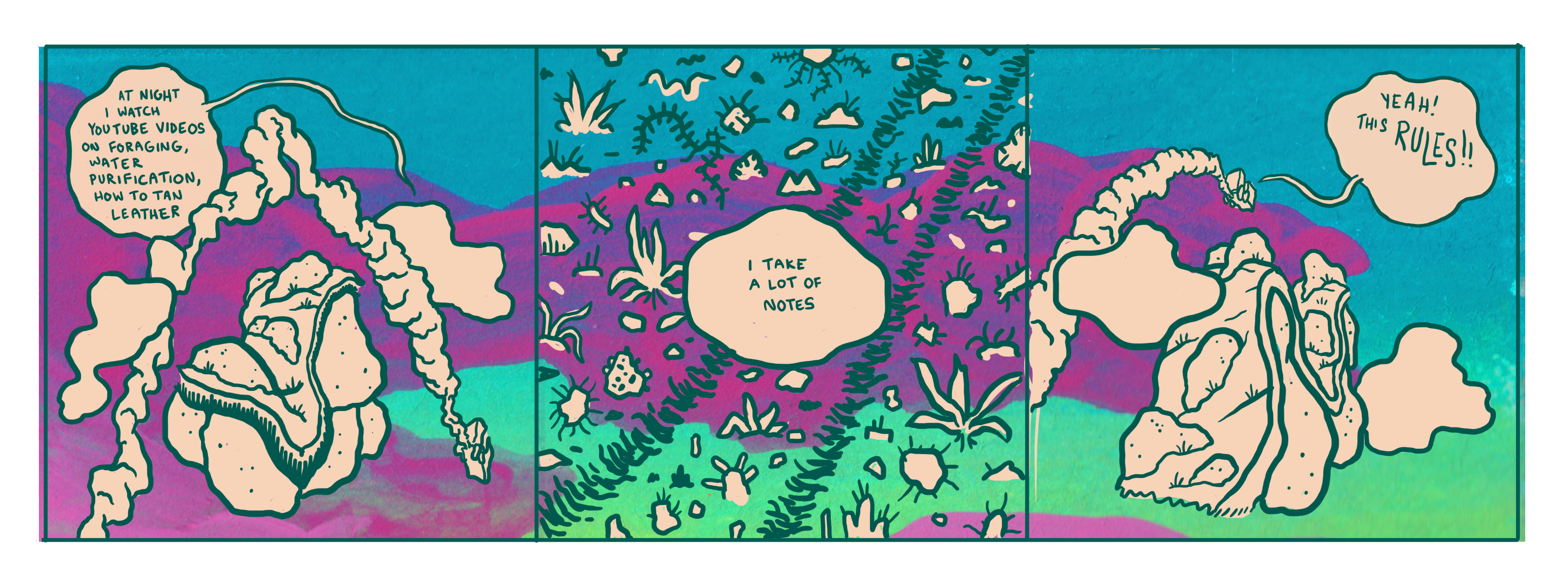Sam Ombiri on Patrick Kyle’s Don’t Come in Here; Gloria Rivera on The Wandering Life of Sanmao; Ronald Wimberly at RISD.
—————————————————————————————————
Sam Ombiri here: The first time I read Don’t Come In Here by Patrick Kyle I was glued to it, ready to see whatever, no matter how mundane, happen. From the beginning it felt like it had a lot of potential, and it delivered on this potential. In the beginning of the book, Patrick Kyle is creating empty space, and along with that he brings on board a sense of potential for discovery of this space being explored that constantly warps and morphs but then returns to it’s original form. Each page has two panels with every so often one page with just one panel, so the constant morphing is rhythmic – it’s unexpected but feels very right, and when it doesn’t feel right it’s hilarious. It’s a really funny book, like when the ghosts that appear are being really comically sensitive,and caring way way too much. It’s a wholly unexpected turn to the established rhythm and grounded boredom that has been taking place. The computer is maybe my favorite character, because the computer presents the most surprises. For the most part, the computer just says mundane things, completes mundane tasks, like loading this, searching this, except every now and then it suddenly surprises us, the reader. To the main character it just seems like a normal thing.
Patrick said of his books before Don’t Come In Here, “All my comics were just drawing based, they’re just about doing crazy drawings, and that was it, the bulk of my early career is like my juvenile where everything was just about the way things looked. So I feel all my comics like Black Mass, my first book, was all about the visual impact of the whole thing and not really about the writing at all.”
The drawings are not only being concernedwith the visual impact in Don’t Come In Here. The drawings are not at the expense of the story, they are working together in harmony. I myself have not read his other mentioned work so I cannot speak to it, but Patrick seems to be criticizing his previous work for them not being so concerned with the writing. “Distance Mover started the same way. It was just all about creating a visual thing. I really never thought too much about writing and storytelling much to be honest until Michael (Deforge) and and I were doing these series, that we call blank comics. Every issue has a theme; like a cop comic basketball comic, Pixar’s Cars comic, Christmas comic and so on, and we did a bunch of them, and the first one I did was just shitty and I kept going, and I was just getting into these really stupid topics and building little stories about them. I felt that really helped my writing out.”
He later says “The images are secondary now or maybe there’s a balance between the writing and the images.” So then judging from what Patrick said here, and reading the book, it feels like Patrick is exercising restraint by only drawing a certain way, and drawing certain things, and not just going insane with the drawings and abandoning the story that he has set in mind. It very much shows! At times the character walks and then while the character is walking Patrick does what I read as just a joke of the pace and maybe the mood the character is walking, but then again it could just be the character shape-shifting, or it could be both. Because of the presentation, when change occurs it is, not so much unsettling for us as the readers, but we can imagine for the character that it is. I am really into the extra dimension Patrick adds to doing the most boring tasks. He adds the sense of a bizarre perspective to things like your food expiring, or having the thought that you’ve almost cleaned up everything only for the mess to resurface. It is stuff like that which makes me enjoy really excited about engaging with this medium. Again, the first time I read Don’t Come In Here every event that had happened, and that was going to happen in it despite how mundane, was exciting. – Sam Ombiri
Get a copy of Patrick Kyle’s Don’t Come In Here from Copacetic Comics – HERE.

—————————————————————————————————
Gloria Rivera writes about Zhang Leping’s manhua The Wandering Life of Sanmao (三毛流浪记) for Comics Workbook:
“The drawing of the original black and white comic is superb, and though never published in the US is completely readable through images alone. Except for signage and a handful of panels, the bulk of the comic is pantomime. Even the dialogue expressed between characters is drawn and not written! Although the relationship between words and pictures in comics should never be debased (as it may be in the show-don’t-tell school of comics) the silence experienced in this comic is unbreakable, and this is a comic that keeps you within its timing, only refraining for pauses of humor, a softness. Leping’s work is noble, leaving his reader in awe of how a man who has experienced so much can describe innocence as he does. This particular collection of comics has been adapted into color comics, animation, film and even live theater productions over the span of 80 years.“
Read more HERE and see a lengthy excerpt from the comic.
—————————————————————————————————
Ronald Wimberly spoke at RISD awhile back but they finally posted the video of the talk online – check it out HERE.
—————————————————————————————————
Blinkers – 4-13-2017 – by Jack Brougham
—————————————————————————————————
Suzy and Cecil – 4-13-2017 – by Tyler Landry
—————————————————————————————————
Joanie and Jordie – 4-13-2017 – by Caleb Orecchio





